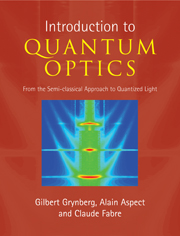Book contents
- Frontmatter
- Contents
- Foreword
- Preface
- Acknowledgements
- Part I Semi-classical description of matterlight interaction
- 1 The evolution of interacting quantum systems
- Complement 1A: A continuum of variable width
- Complement 1B: Transition induced by a random broadband perturbation
- 2 The semi-classical approach: atoms interacting with a classical electromagnetic field
- Complement 2A: Classical model of the atom-field interaction: the Lorentz model
- Complement 2B: Selection rules for electric dipole transitions. Applications to resonance fluorescence and optical pumping
- Complement 2C: The density matrix and the optical Bloch equations
- Complement 2D: Manipulation of atomic coherences
- Complement 2E: The photoelectric effect
- 3 Principles of lasers
- Complement 3A: The resonant Fabry–Perot cavity
- Complement 3B: The transverse modes of a laser: Gaussian beams
- Complement 3C: Laser light and incoherent light: energy density and number of photons per mode
- Complement 3D: The spectral width of a laser: the Schawlow–Townes limit
- Complement 3E: The laser as energy source
- Complement 3F: The laser as source of coherent light
- Complement 3G: Nonlinear spectroscopy
- Part II Quantum description of light and its interaction with matter
- Part III Applying both approaches
- Index
Complement 3C: Laser light and incoherent light: energy density and number of photons per mode
Published online by Cambridge University Press: 05 August 2012
- Frontmatter
- Contents
- Foreword
- Preface
- Acknowledgements
- Part I Semi-classical description of matterlight interaction
- 1 The evolution of interacting quantum systems
- Complement 1A: A continuum of variable width
- Complement 1B: Transition induced by a random broadband perturbation
- 2 The semi-classical approach: atoms interacting with a classical electromagnetic field
- Complement 2A: Classical model of the atom-field interaction: the Lorentz model
- Complement 2B: Selection rules for electric dipole transitions. Applications to resonance fluorescence and optical pumping
- Complement 2C: The density matrix and the optical Bloch equations
- Complement 2D: Manipulation of atomic coherences
- Complement 2E: The photoelectric effect
- 3 Principles of lasers
- Complement 3A: The resonant Fabry–Perot cavity
- Complement 3B: The transverse modes of a laser: Gaussian beams
- Complement 3C: Laser light and incoherent light: energy density and number of photons per mode
- Complement 3D: The spectral width of a laser: the Schawlow–Townes limit
- Complement 3E: The laser as energy source
- Complement 3F: The laser as source of coherent light
- Complement 3G: Nonlinear spectroscopy
- Part II Quantum description of light and its interaction with matter
- Part III Applying both approaches
- Index
Summary
The difference between laser light and the light emitted by an incoherent source can only be fully appreciated with reference to certain notions of energetic photometry, which are spelt out in the first part of this complement. It will be shown in Section 3C.2 how the laws of photometry drastically reduce the energy density that can be obtained from a conventional incoherent source (such as a heated filament, or a discharge lamp) in comparison with a laser source (Section 3C.3). Far from being merely circumstantial, these laws for classical sources are of a fundamental kind that can be deduced from the basic principles of thermodynamics. Another way to relate these properties of light to the fundamental principles of physics is to examine them in the context provided by the statistical physics of photons, as will be discussed in Sections 3C.4 and 3C.5.
Conservation of radiance for an incoherent source
Étendue and radiance
An incoherent source comprises a large number of independent, elementary emitters, emitting electromagnetic waves with a random distribution of uncorrelated phases. It emits light in every direction. A light beam produced by this source can be decomposed into elementary pencils of light. Since the light is incoherent, the total power carried by the beam is the sum of the powers carried by the elementary pencils.
An elementary pencil is defined by the element dS of the source from which it originates, and a second surface element dS′, as shown in Figure 3C.1.
- Type
- Chapter
- Information
- Introduction to Quantum OpticsFrom the Semi-classical Approach to Quantized Light, pp. 247 - 256Publisher: Cambridge University PressPrint publication year: 2010
- 1
- Cited by



